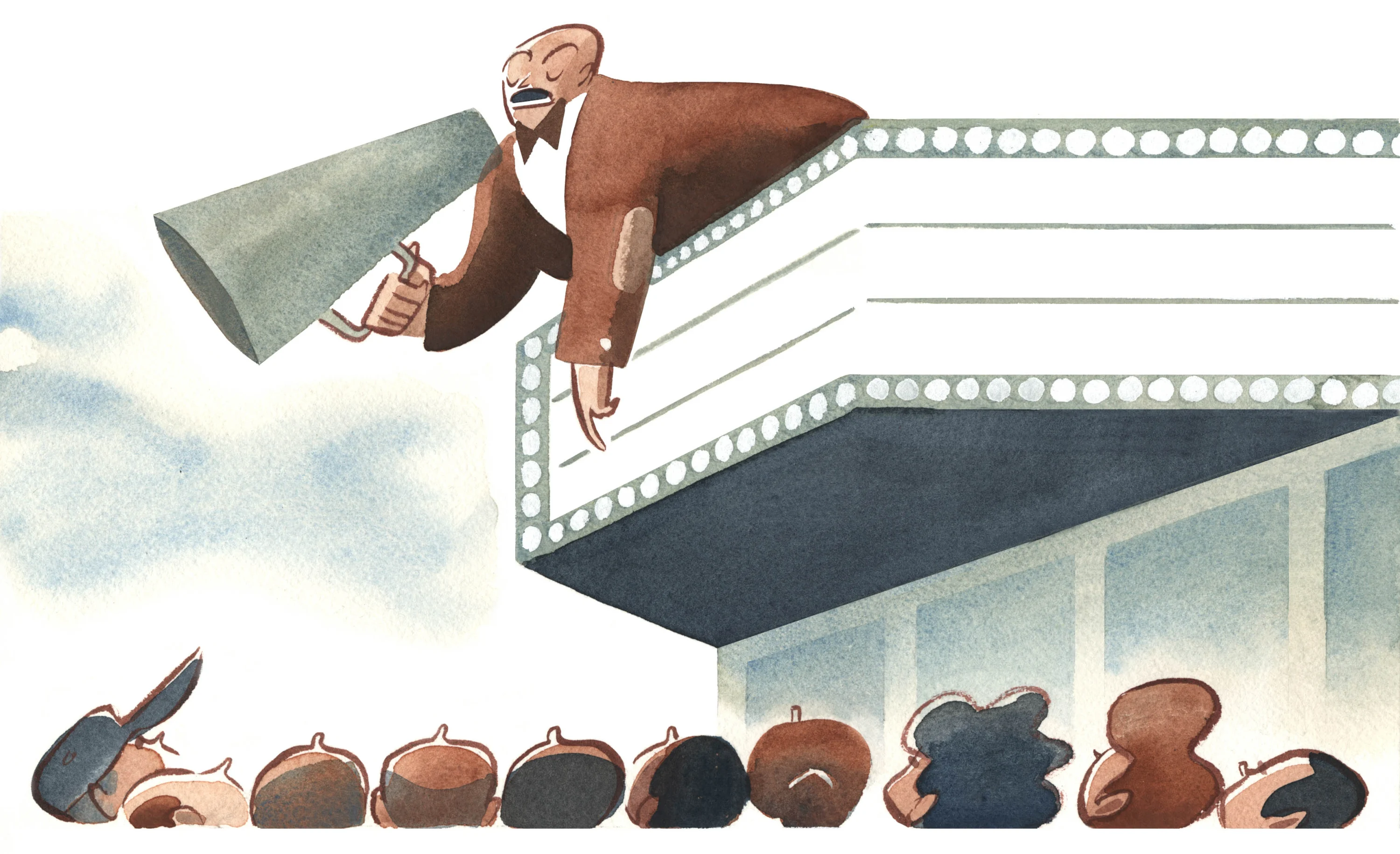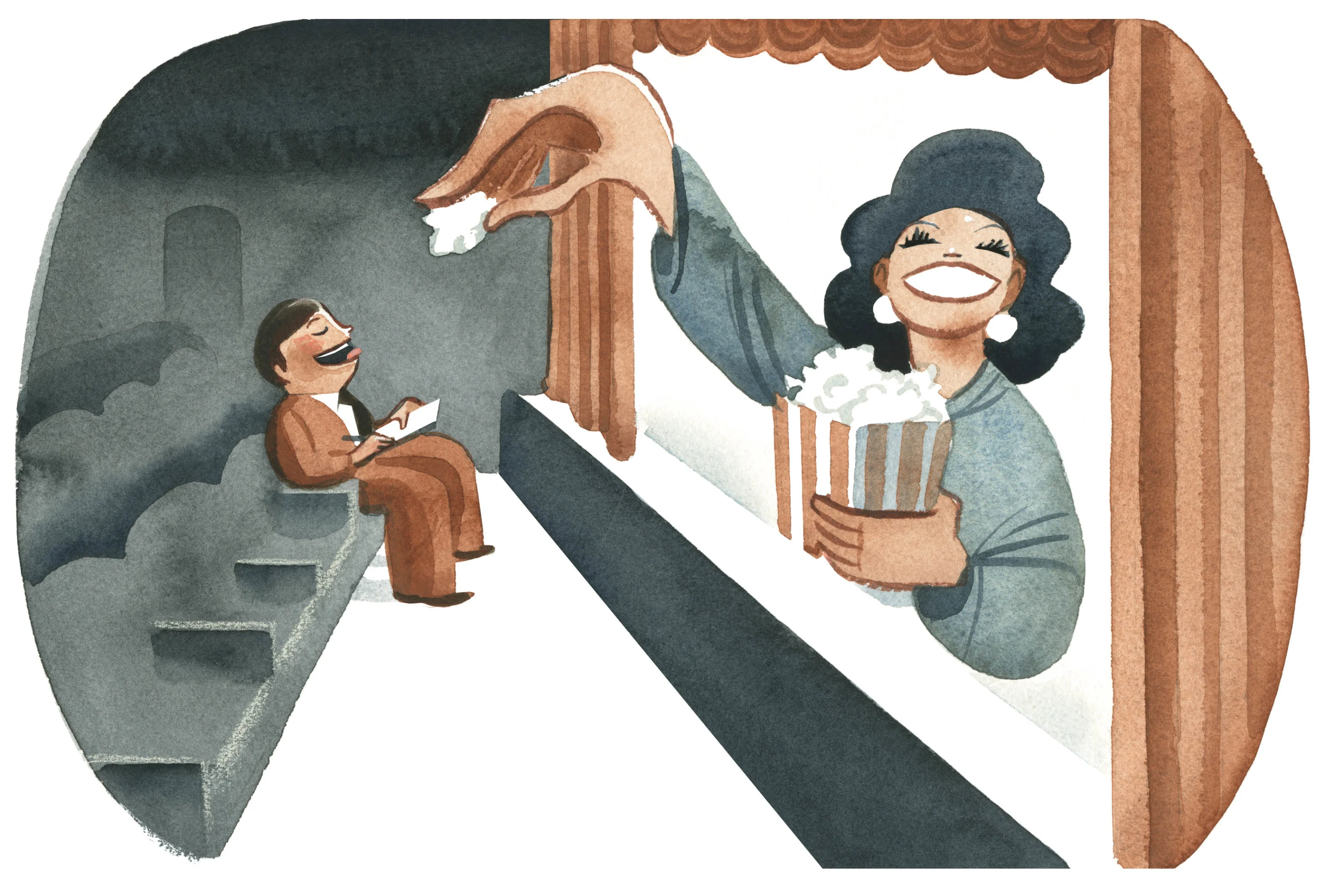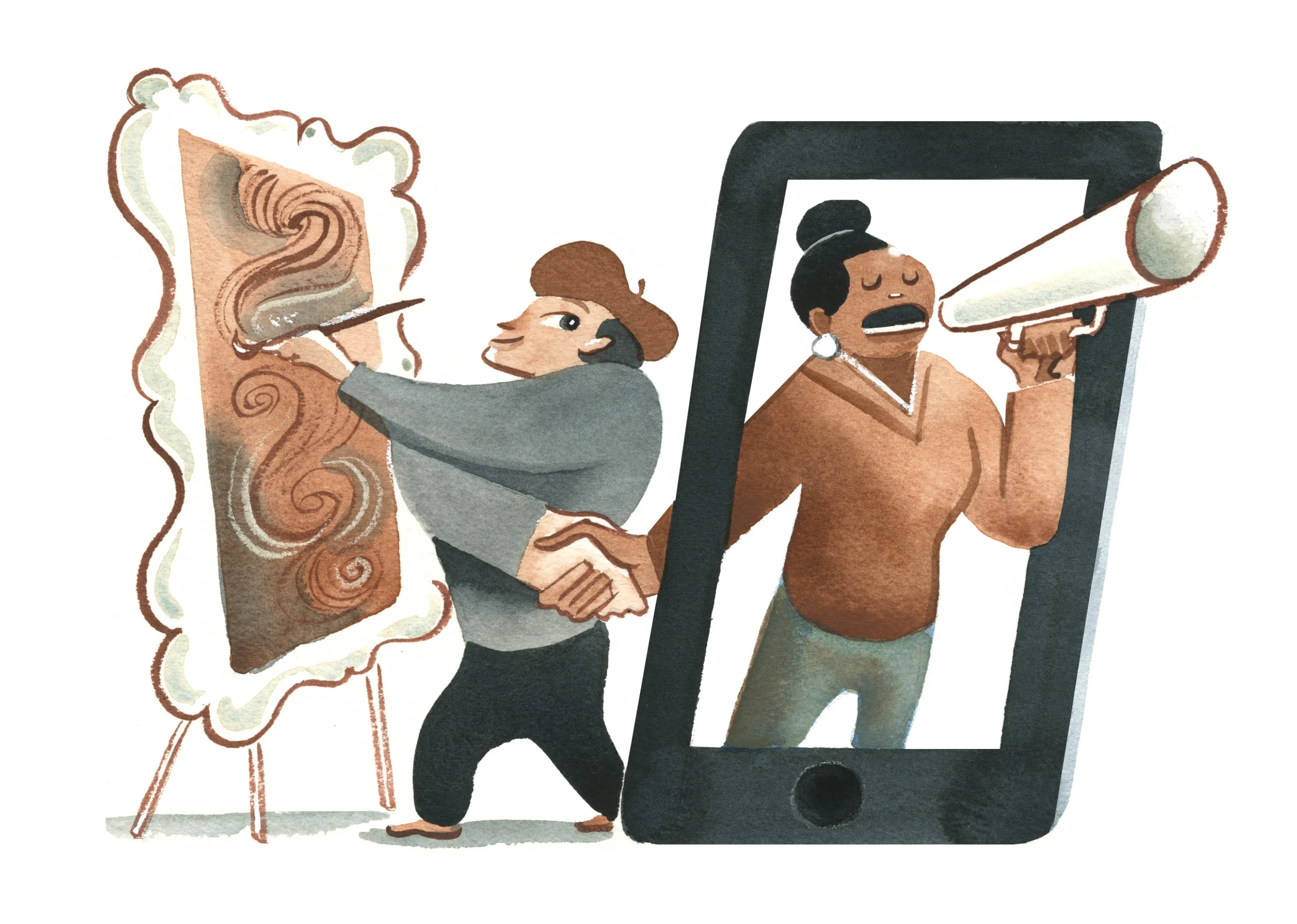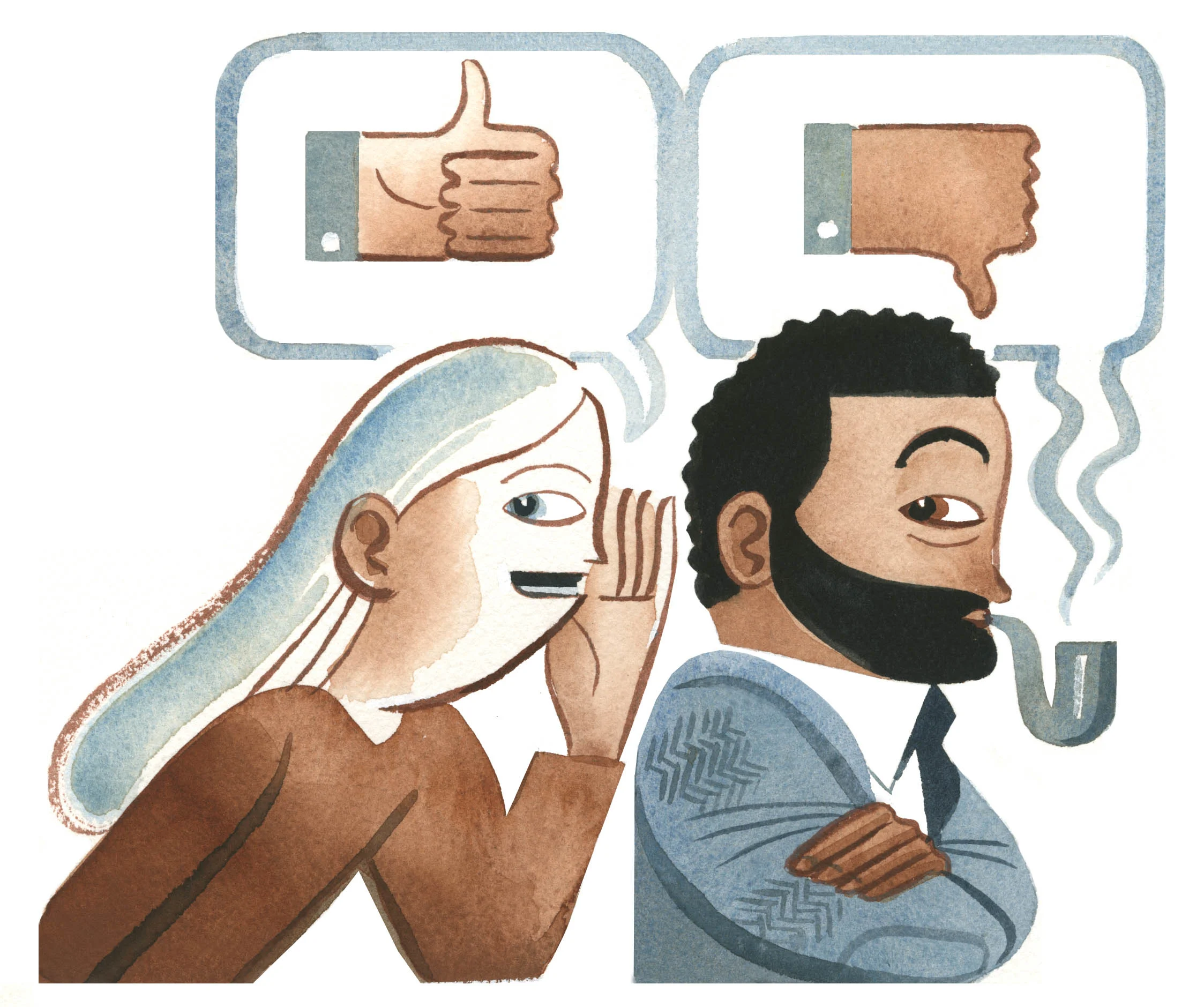

As heritage media budgets have plummeted and social media has become the dominant site for discourse, arts critics are increasingly marketing themselves as much as their work to make their voices heard. Here, writer Simran Hans explores the dangers of commodifying the critic.
Illustrations by Marcellus Hall.
“A critic with a cult is a critic under peculiar stress,” wrote Renata Adler in her review of Pauline Kael’s collected film criticism. Published in 1980, in the New York Review of Books, her historic hit piece lambasts Kael’s chatty, overfamiliar writing style and argues that the “presumptuous ‘we’, the intrusive ‘you’” and “the debased note of righteousness and rude instruction” used by the New Yorker’s star film critic was reliant on her audience’s “incapacity to read.” Ouch. In other words, Adler felt Kael had leveraged her forceful personality and her combustible opinions for the likes. In doing so, she had built a cult following of idiots.
(Adler, best known as a reporter, had spent a year working as a film critic for the New York Times between 1968 and 1969. Famously, she hated it.)
Adler despaired at the way that films had become brands for a critic to endorse. She compared reviews to marketing copy, wrinkling her nose at movie marquees that feature pull quotes from reviews, and even worse, critics’ names. She was writing about the 1980s, but her words feel relevant now. No doubt she’d raise an eyebrow at the critic-influencer who posts photos of their PR-#gifted merch on Instagram. A mug, a t-shirt, a copy of the book the movie was based on. If you’re lucky, a bottle of natural wine.

Apparently, the serious work of criticism—discussing an artwork in detail, parsing a judgment, figuring out its meaning—has always been in danger of being devalued.
But criticism as work has been devalued, too. Print and digital publications are streamlining their operations or else folding. The few staff jobs left in heritage media are mostly retained by critics who have held onto their posts (and salaries) for decades. Writers of color are being parachuted in as cheap and easily replaceable contractors, while their outlets benefit from the optics of diversity. In general, rates for freelance writers have stagnated, while the cost of living continues to rise. In a period of economic instability, the currency of social media is all there is left. Critics, and criticism, are more precarious than ever. It’s no wonder some arts journalists are leaving criticism to make better money writing copy for tech giants like Apple and Netflix. Except, in April 2022, Netflix’s editorial fansite Tudum gutted its staff less than six months after launching.
I came of age in the late 2000s, in a suburb of Birmingham, England. I loved movies and watched a lot of them on DVD, which were cheap and readily available. I had the internet on our family computer, but not on my mobile phone. Streaming was still a few years off. The way I learned about culture was through newspapers and magazines. At WHSmith and Borders, I would flip through copies of Sight and Sound and imported editions of Rolling Stone. I saw the critic as an authority figure, a person to look up to and learn from. How else would I know what to watch?
In a period of economic instability, the currency of social media is all there is left. Critics, and criticism, are more precarious than ever.
But as I started spending more time online, something began to shift. I joined Tumblr and read a lot of blogs. I found myself less interested in reviews than I was in a community of other teenage girls whose posts explored things like fashion, friendship, identity, and desire through film stills, gif sets, playlists, and personal essays. My knowledge networks had been decentralized. In her book, “Poor Little Sick Girls,” the writer and founder of Polyester Zine Ione Gamble describes this era as one in which you didn’t need to be an expert to cultivate a following. Instead, communities formed around people whose online identities they could relate to “on a visual, political and personal level.” The personal-essay boom of the 2010s underlined the importance of having a point of view.
It was a time in which writers could pitch their tents online and self publish whatever they liked. For too long, white men of a certain demographic were considered the default, shaping the culture through their criticism. Blogs were a kind of digital revival of the DIY zine culture of the 1990s. Everyone could participate; the online real estate had not yet been gentrified. Trend forecaster and writer Ayesha A. Siddiqi writes that corporations soon began to understand “personal subjectivity” as something that could be “leveraged to sell and be sold to.” Identity politics were marketable. Social media platforms like Facebook and Instagram encouraged users to see themselves as content creators, whose posts—supposedly an expression of their personalities, tastes, and politics—had a value based on likes and shares. A new generation of writers learned to market themselves as commodities, instead of their work.
The blogs were democratic but unprofitable, and so eventually died. But the social media platforms that people once used to promote their writing are thriving.

In the early 2010s, one of my favorite blogs was Ultra Culture, a movie blog created by the critic-turned-filmmaker Charlie Shackleton. It was funny and frequently rude, with a pointedly irreverent attitude towards the film industry and its marketing tactics. I asked Shackleton what role Twitter played during his stint as a blogger. “Twitter existed, but essentially as a tool to point people towards my blog,” he said. It was an arrow that led people to longer-form writing that attempted to explore ideas with some degree of nuance. “My sense now,” he said, is that now, for many freelance critics, “the social media accounts are the destination for their output” and it’s about “how much you can leverage that.”
Shackleton thinks that something changed when the retweet button replaced the manual “RT” in 2009. Twitter users could share others’ tweets with a single click. “I think [retweets] started to mean so much more than the invisible metric of visits to a blog post. Because realistically, how many people are going to read your review for a minor outlet of a film that played at Cannes, versus the impression of thousands of retweets you might get on a snappily-worded tweet about that same film?”
A new generation of writers learned to market themselves as commodities, instead of their work.
But it’s not social media that has tainted criticism, according to A.S. Hamrah, author of “The Earth Dies Streaming” and film critic for the Baffler. “Whatever is the newest medium is the most despised medium. Movies were seen as dangerous and evil, radio was seen that way, television was seen that way, the internet was seen that way. But it’s not that. It’s the rise of corporate control,” he said. Hamrah locates the problem as the merging of entertainment journalism and criticism during the blockbuster era. “Criticism is not marketing. It’s been made into marketing.”
In his own criticism, he refuses to cooperate, dispensing with conventional plot summaries and publishing outside the release schedule. “The idea that all movies have to be reviewed on the Friday they come out, that really hurt criticism,” he said. The window to have a critical response shrinks; the window in which that response is deemed relevant becomes even smaller. It’s more important to be first than to be definitive. Studios and streamers, he said, use embargos to exert control over their films. “They say to a newspaper, we’re not going to advertise in your paper unless you respect this embargo. They say we’d like you to not review this film until the day it comes out. They [the newspaper] need the advertising money from the motion picture industry. Obviously, this is a form of collusion.”

Hamrah’s path is not easily replicable. He came up through zines and the early website Suck.com. More recent homes for his writing, like n+1 and the Baffler, also sit outside the mainstream.
The antagonism, however, is a healthy critical stance. Critics should approach brands and tech platforms with skepticism, and not as friendly collaborators. Ambivalence is a form of resistance, as the New Yorker critic Doreen St. Félix has said. A critic is not a cheerleader. To critique something generously is to offer analysis, and assessment. To make sense of an artwork’s aesthetic and political value, we need people who are able to untangle it from its merit as commerce. We need critical integrity, now more than ever.

